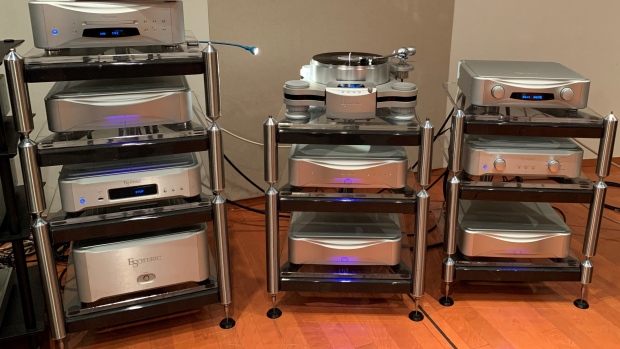Nov 1, 2022
This $50,000 Japanese Turntable Is What Your Vinyl Has Been Waiting For
, Bloomberg News

(Bloomberg) -- Sales of vinyl records topped $1 billion last year for the first time since 1986. That was the year before Esoteric Co. was established as a niche high-end digital brand for the burgeoning audio revolution ushered in by CD players.
More than three decades and a whole lot of design later, the company has released its first-ever analog turntable. And the Grandioso T1 has a weight to match its eye-watering price tag.
Priced at 7,700,000 yen ($52,000), the T1 features a contoured brushed aluminum chassis similar to the company's other components. It looks more like something you'd expect to see in a NASA lab or five-star kitchen. It's a behemoth at nearly 100 pounds — about four times the weight of the ubiquitous Technics SL 1200 favored by club DJs.
The bulk comes from the massive platter on which the record sits and rotates. This is the first feature that catches the eye, looking more like a single-layer metallic cake than the overturned dinner-plate profile of most other models. The piece is hand-polished to remove imperfections and weighs 19 kilograms (42 pounds), providing a solid base for minimal vibration.
Esoteric employs unique magnetic technology in two different ways in the T1. The "Magne-Float" set-up helps effectually lower the platter's weight by about 80% to reduce friction on the spindle bearing. Meanwhile, the patented "MagneDrive System" motor spins the platter via induction, making no direct contact as is usual with traditional belt or direct-drive turntables. All of this is aimed at smooth, distortion-free rotation.
The plinth is designed to further reduce vibration, with two aluminum slabs sandwiching a piece of wood painted with high-gloss piano lacquer. Up to three tonearms can be attached to accommodate various cartridge types for playing different types of records (pop versus classical, for example, or brand new 180 gram pressings versus old worn vintage records).
The company's soundroom, where I tested the turntable, is an ideal listening environment. Solid walls in a loose-pleat pattern prevent reflections, and soft padded treatments absorb sound. The elephant in the room — roughly the same size as a baby pachyderm, anyway — is the Avantgarde Acoustic Trio and Spacehorn speaker system, which, had you the room for them to shine, would set you back more than $250,000.
We listened first to Aaron Copland's "Fanfare for the Common Man," as performed by the Minnesota Orchestra (Eiji Oue, conductor). Played on the T1 through Esoteric amplification, rich, clear horn sounds separated from the ominous rumble of the drums and shimmering tam-tam. The sound was live and beautiful, though admittedly I imagine even a compressed Spotify copy played via an iPhone would probably sound great through those speakers in that particular room.
Next up was "Isolation" by Hiromi Uehara's quintet. With a broader range of instruments, each tone was distinct. The warm dynamics of the piano, the hush between notes, even the most subtle sounds from the bow on the violin strings to the taps on the fingerboard. The whole experience made me regret that I hadn't been bold enough to bring along some of my own rock records for a Risky Business-esque spin, in a bid to discover details I'd not heard before.
So, almost 40 years after Tom Cruise famously danced in his socks, why has Esoteric finally decided to join the vinyl party?
With parent company Teac Corp. already having an established turntable presence, Esoteric felt it could take its time to develop something that would leverage its expertise and consumer recognition in digital source machines, and stand out from the crowd. It took five years to create the T1.
"There had been no innovation for 100 years," Hiroshi Oshima, Esoteric's president said in our discussion of turntables. While a number of magnetic-drive turntables have emerged in the past few years, Oshima said the T1 takes a different approach, drawing on technology used in medical instruments and semiconductor production gear to manipulate objects with minimal outside interference or contamination.
The lengthy development time, during which the company gradually leaked details of the machine, helped create a buzz among the brand's fans ahead of its release in October, to commemorate Esoteric's 35th anniversary. Oshima said initial demand had outstripped the company's expectations.
Sales at parent Teac rose nearly 10% in the fiscal year ended March to ¥16 billion ($110 million), ending a steady two-decade decline. Esoteric said that overseas business has become the focus, now accounting for 70-80% of demand for high-end Japanese audio products versus 20-30% in the past.
While China is seen as an important growth market for the company as a whole, it's not a target audience for the T1 due to its lack of a legacy record culture. The main target customers are keen-eared, affluent North Americans and Europeans.
And while much has been made of the T1's price, it's hardly the most expensive turntable on the market, with a number of mostly European-made products breaching $200,000, such as the Transrotor Argos. But still, it's not cheap.
"Even wealthy people wouldn't buy something like this unless they're an audiophile," Oshima admitted. "Then there are some that will buy it even if they don't have the money — they'll take out a loan."
--With assistance from Marika Katanuma.
©2022 Bloomberg L.P.





